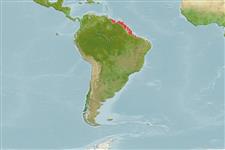Environment: milieu / climate zone / depth range / distribution range
Écologie
marin; saumâtre démersal; profondeur 15 - 20 m (Ref. 86589). Tropical; 9°N - 7°S, 60°W - 34°W
Western Atlantic: Coastal rivers from Guyana to northern Brazil.
Length at first maturity / Taille / Poids / Âge
Maturity: Lm 52.5, range 46 - 59 cm
Max length : 190 cm TL mâle / non sexé; (Ref. 86589); common length : 90.0 cm TL mâle / non sexé; (Ref. 86589); poids max. publié: 50.0 kg (Ref. 5217); âge max. reporté: 4 années (Ref. 51994)
Épines dorsales (Total): 1; Rayons mous dorsaux (Total): 7; Rayons mous anaux: 18 - 20; Vertèbres: 49 - 51. This species is distinguished by the following characters: in life, yellowish body; swim bladder divided into 3 chambers; shield-shaped nuchal plate, usually larger than the supraoccipital process; head shield exposed and granulated in orbital and postorbital regions; first 2 gill with no mesial gill rakers. Sciades parkeri can further be distinguished from sympatric congeners by the following: fleshy furrow connecting posterior nares absent (vs. present in S. couma, S. herzbergii and S. passany); moderately sized posterior chamber of swim bladder (vs. small in S. proops; absent in S. couma, S. herzbergii, S. passany); nuchal plate with no anterior notch (vs. anterior notched in S. proops, sometimes notched in S. herzbergii); palatal patches forming a U-shaped band (vs. transverse in S. passany, lateral edge on accessory patches not emarginated or shallowly notched; lateral edge with an angled and pronounced notch in S. proops) (Ref. 86589).
Mainly found in turbid waters over muddy bottoms in coastal areas, estuaries and lower parts of rivers. Sexually mature after around two years of age. Upon hatching, the alevins are relatively large, approximately 6.0-6.5 cm (Ref. 35381). Marketed fresh and salted (Ref. 5217). Fish exported to Canada, USA, England, and Holland (Rayman Bedessee, pers. comm.).
Life cycle and mating behavior
Maturité | Reproduction | Frai | Œufs | Fécondité | Larves
Distinct pairing. May employ mouth booding as parenting strategy (Ref. 205).
Betancur-R., R.: Marceniuk, A.P. and P. Béarez, 2008. Taxonomic status and redescription of the gillbacker sea catfish (Siluriformes: Ariidae: Sciades parkeri). Copeia 2008(4):827-834. (Ref. 86589)
Statut dans la liste rouge de l'IUCN (Ref. 130435)
Menace pour l'homme
Traumatogenic (Ref. 58010)
Utilisations par l'homme
Pêcheries: intérêt commercial mineur
Plus d'informations
RéférencesAquacultureProfil d'aquacultureSouchesGénétiqueElectrophoresesHéritabilitéPathologiesTraitementNutrientsMass conversion
CollaborateursImagesStamps, Coins Misc.SonsCiguateraVitesseType de nageSurface branchialeOtolithesCerveauxVision
Outils
Articles particuliers
Télécharger en XML
Sources Internet
Estimates based on models
Preferred temperature (Ref.
123201): 27.3 - 28.3, mean 27.7 °C (based on 174 cells).
Phylogenetic diversity index (Ref.
82804): PD
50 = 0.5039 [Uniqueness, from 0.5 = low to 2.0 = high].
Bayesian length-weight: a=0.00871 (0.00500 - 0.01517), b=3.10 (2.95 - 3.25), in cm total length, based on LWR estimates for this species & (Sub)family-body (Ref.
93245).
Niveau trophique (Ref.
69278): 4.1 ±0.6 se; based on diet studies.
Résilience (Ref.
120179): Haut, temps minimum de doublement de population inférieur à 15 mois (K=0.46; tm=2; tmax=4).
Prior r = 0.76, 95% CL = 0.48 - 1.20, Based on 1 stock assessment.
Fishing Vulnerability (Ref.
59153): Very high vulnerability (90 of 100).
Nutrients (Ref.
124155): Calcium = 63.8 [33.6, 136.7] mg/100g; Iron = 1.04 [0.63, 1.87] mg/100g; Protein = 17.8 [16.1, 19.6] %; Omega3 = 0.215 [0.116, 0.403] g/100g; Selenium = 61.9 [29.2, 143.4] μg/100g; VitaminA = 11.7 [4.2, 32.3] μg/100g; Zinc = 0.723 [0.467, 1.124] mg/100g (wet weight);
